XML Protocol Usage Scenarios
Draft
(16th October 2001)
This version:
@@@
Latest version:
@@@
Contributors:
(alphabetical)
John Ibbotson, IBM Corporation, (
john_ibbotson@uk.ibm.com )
Copyright
©2001 W3C
® (
MIT , INRIA
, Keio ), All Rights Reserved. W3C liability
, trademark
, document
use and software
licensing rules apply.
Abstract
This document describes the XML Protocol
Usage Scenarios and how they may be implemented using the SOAP 1.2
specification
Status of this Document
This document is not a W3C
Technical Report. It is to be considered a work in progress and does not
imply endorsement by the W3C membership nor by the XML Protocol WG.
As a work in progress this
document represents the current state of the Usage Scenarios. It is currently
under review and discussion by the XML Protocol WG.
Discussion of this document will
take place on the public <
xml-dist-app@w3.org > mailing list ( Archives ) as
indicated by the email
communiation rules provided in the WG charter.
Table of Contents
2. Documentation of Usage Scenarios
2.1 S1 Fire-and-forget to single receiver
2.2 S2 Fire-and-forget to multiple receivers
2.4 S4 Remote Procedure Call (RPC)
2.5 S5 Request with acknowledgement
2.6 S6 Request with encrypted payload
2.7 S7 Third party intermediary
2.8 S8 Conversational message exchange
2.9 S10 Message header and payload encryption
2.10 S11 Communication via multiple intermediaries
2.11 DS17 Asynchronous messaging
2.13 S20 Multiple asynchronous responses
2.14 S21 Incremental parsing/processing of XMLP messages
2.20 S809 Caching with expiration
Issues
1.
This is an
initial draft document - no issues raised so far.
2.
Need to add
scenarios S21, DS24, S805, S807, S809 and S810 and more SOAP examples
1. Introduction
Introduction to the usage
scenarios.
2. Documentation of Usage Scenarios
2.1 S1 Fire-and-forget to single receiver
2.1.1 Scenario
Definition
A sender wishes to send an
unacknowledged message to a single receiver (e.g. send a stock price update
every 15 minutes)
2.1.2
Description
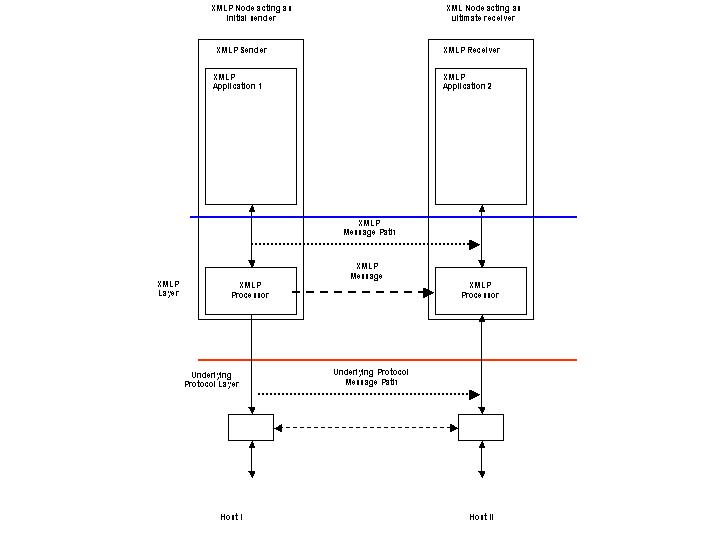
Figure 1 Fire-and-forget to single receiver
A “fire-and-forget” feature in scenario S1 requires a mechanism to send a message to a single XMLP Receiver and is illustrated in Figure 1. The XMLP Sender does not require any status information that the message has been sent to or received by the recipient. The underlying transport protocol may implement a response mechanism, but status on whether the message was successfully sent or otherwise is not returned to the sending XMLP Processor. This may be implemented using the XMLP_UNITDATA.send() primitive at the XMLP Sender.
2.2 S2 Fire-and-forget to multiple receivers
2.2.1 Scenario
Definition
A sender wishes to send
unacknowledged messages to a set of receivers (e.g. send a stock price update
every 15 minutes)
2.2.2
Description
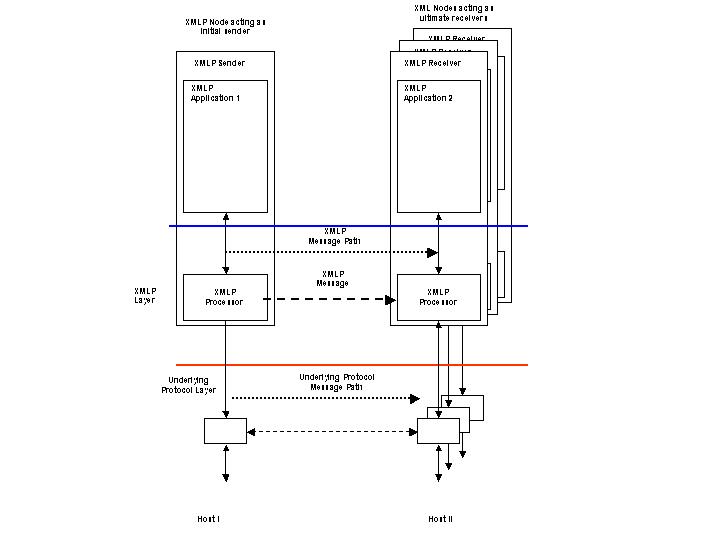
Figure 2 Fire-and-forget to multiple receivers
Scenario S2 extends S1 to implement a “fire-and-forget” feature to multiple XMLP Receivers and is illustrated in Figure 2. This requires a mechanism to deliver the same message to multiple XMLP Receivers. The delivery of the messages could be implemented using multicast distribution technology if the underlying transport layer supports this. An alternative implementation may use repeated applications of scenario S1 with a distribution list of intended recipients.
2.3 S3
Request/Response
2.3.1 Scenario Definition
Two parties wish to conduct electronic business by the
exchange of business documents. The sending party packages one or more
documents into a request message, which is then sent to the receiving party.
The receiving party then processes the message contents and responds to the
sending party. Examples of the sending party's documents may be purchase order
requests, manufacturing information and patient healthcare information.
Examples of the receiving party's responses may include order confirmations,
change control information and contractual acknowledgements.
2.3.2
Description
Scenario S3 requires a “request/response” message feature. A request containing some business document is sent by an XMLP Sender to an XMLP Receiver where some business application is invoked. The business application processes the request and generates a response, which is returned to the XMLP Sender that originated the request. Two alternative solutions are described which depend upon the characteristics of the underlying transport layer. In either case, the XMLP Sender is informed of the status (successful or otherwise) of the request message delivery.
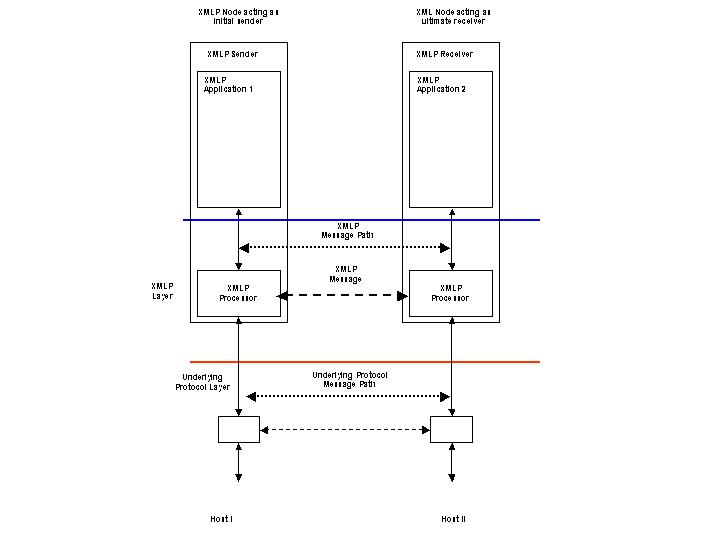
Figure 3 Request/Response using underlying
transport
If the underlying transport
protocol supports the correlation of a request and its matching response
directly, then the solution illustrated in Figure 3 may be appropriate. An
example of such an underlying transport protocol would be a synchronous HTTP
POST. This implementation would make use of the transport binding proposed in
other XML Protocol WG documents. The business document sent as a request by the
XMLP Sender would be inserted as the payload of the request message. Following
the receipt of the request, the processing application would generate the a
document which would be returned as the payload of the response message with
appropiate status codes. If for whatever reason, the request message was not
received or processed by the intended business application, suitable status
messages would be generated by the underlying transport layer and reported to
the XMLP Sender.
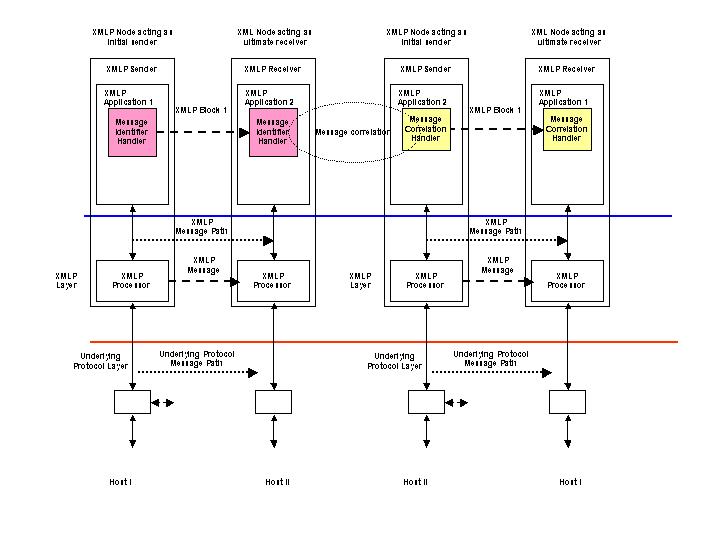
Figure 4 Request/Response using SOAP headers
If the underlying transport protocol does not support a request/response model, then the configuration shown in Figure 4 may be appropriate. Examples of such an underlying protocol may include unidirectional queuing middleware. In this case, message identification and correlation is provided by XMLP Headers. In the request SOAP message, a Message Identifier Handler is responsible for generating a unique message identifier and inserting it into an XMLP Header. This forms part of the SOAP request message and is sent from XMLP Application 1 to the receiving XMLP Application 2. The request message is processed by a business application and a response message is assembled. This includes an XMLP Header built by a Message Correlation Handler which links the response message to its associated request.
Example: SOAP request message containing a message identifier
<env:Envelope xmlns:env="http://www.w3.org/2001/09/soap-envelope"> <env:Header> <n:msgheader xmlns:n="http://example.org/requestresponse"> <n:messageid>uuid:09233523-345b-4351-b623-5dsf35sgs5d6</n:messageid> </n:msgheader> </env:Header> <env:Body> …………… </env:Body></env:Envelope>
Example: SOAP response message containing correlation to original request
<env:Envelope xmlns:env="http://www.w3.org/2001/09/soap-envelope"> <env:Header> <n:msgheader xmlns:n="http://example.org/requestresponse"> <n:messageid>uuid:09233523-567b-2891-b623-9dke28yod7m9</n:messageid> <n:responseTo>uuid:09233523-345b-4351-b623-5dsf35sgs5d6</n:responseTo> </n:msgheader> </env:Header> <env:Body> …………… </env:Body></env:Envelope>2.4 S4 Remote Procedure Call (RPC)
2.4.1 Scenario
Definition
The
sender invokes the service by passing parameters that are serialized into a message
for transmission to the receiving server.
2.4.2
Description
Scenario S4 differs from scenario S3 in
that the request message consists of a set of serialized parameters used to
invoke some remote procedure which responds with the results of invoking the
procedure. This is a different programming model to the document exchange one
illustrated by scenario S3. Scenario S4 requires a request/response mechanism
as in S3, but further XMLP Handlers are required to provide the parameter and
result serialization needeed for the RPC programming model. Figure 5 and Figure
6 add further features to the request/response configuration for scenario S3.
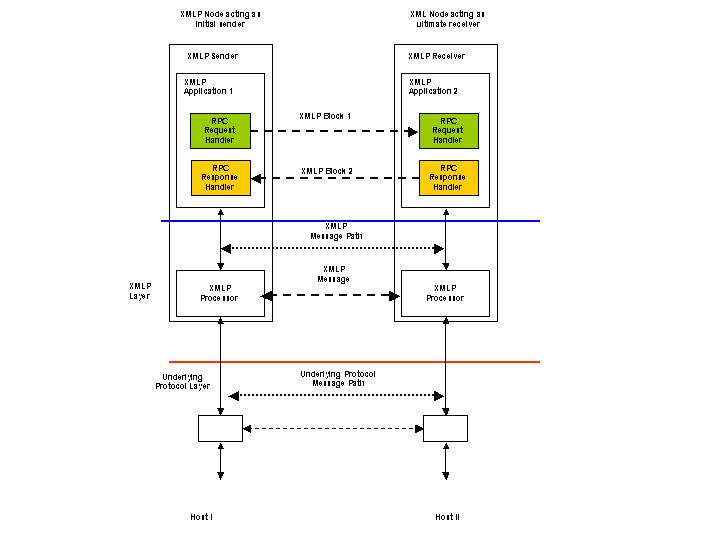
Figure 5 RPC using underlying transport
Figure 5 illustrates an RPC invocation
over an underlying transport protocol such as HTTP that supports
request/response. For the RPC programming model, an RPC Request handler on the
XMLP Sender serializes the calling parameters and places them in an XMLP Header
in the calling request. The XMLP Receiver has a matching XMLP Handler which
extracts the serialized parameters and invokes the procedure (which is local to
the XMLP Receiver). The result is then serialized by the RPC Response Handler
and returned as a response to the XMLP Sender that invoked the RPC.
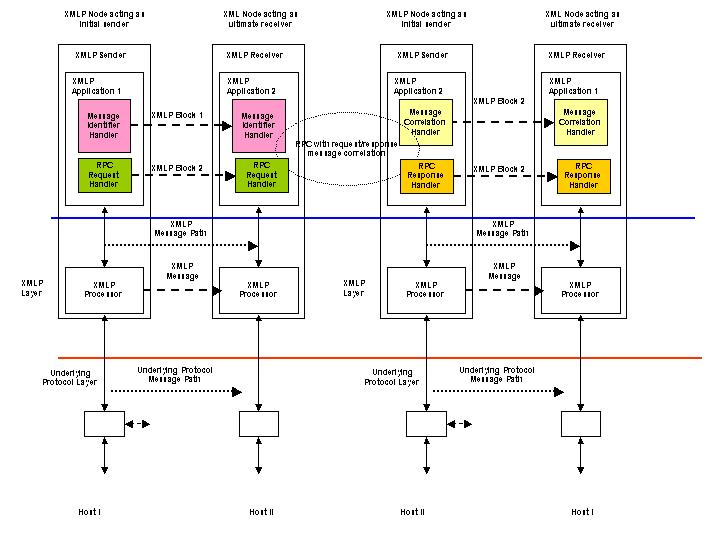
Figure 6 RPC using SOAP headers
In Figure 6, the underlying transport
protocol does not support request/response directly. The RPC Request and RPC
Response Handlers work in the same way to augment the request/response
functionality provided by the Message Identifier and Message Correlation
handlers described in scenario S3.
Note: Provide example SOAP messages for RPC based on TF
conclusions
2.5 S5 Request with
acknowledgement
2.5.1 Scenario
Definition
A sender wishes to reliably exchange data with a receiver. It wishes to be notified of the status of the data delivery to the receiver. The status may take the form of:
- The data has been successfully delivered to the receiver, or
- Some failure has occurred which
prevents the successful delivery to the receiver.
2.5.2
Description
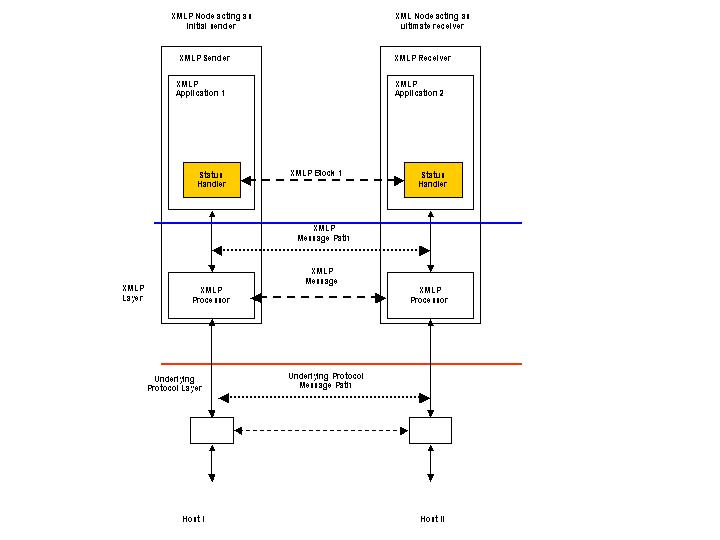
Figure 7 Request with acknowledgement
Figure 7 illustrates a request/response
scenario with the XMLP Sender requesting status information from the matching
XMLP Receiver. This status may provide delivery information to the sender in
addition to other business related responses that the receiving application may
generate. Figure 7 assumes that the underlying transport protocol supports the
request/response exchange model. A Status Handler on registered with the XMLP
Sender is configured to request the status information. A matching handler on
the XMLP Receiver generates the requested status information and places it the
response message which is then returned to the originating XMLP Sender.
Note: Provide example SOAP messages status request and
response
2.6 S6 Request with encrypted payload
2.6.1 Scenario Definition
A
sender wishes to exchange data with a receiver and has agreed to encrypt the
payload. The sending and receiving applications agree on the encryption
methodology. Data is encrypted by the originating application and sent to the
receiver via XMLP. The data reaches the receiving application untouched, and
may then be decrypted in the agreed-upon manner.
2.6.2
Description
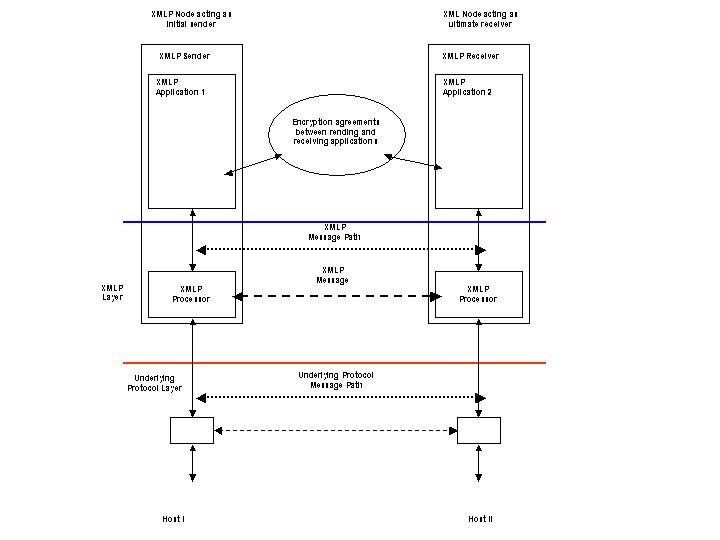
Figure 8 Request with encrypted payload
Scenario S6 describes two applications that wish to share encrypted data as an opaque body in a SOAP message. It places no requirements on the XMLP messaging layer. Figure 8 illustrates this scenario. All agreements between the communicating applications are above the XMLP layer and are outside the scope of the working group.
Note: Need to expand this further
2.7 S7 Third
party intermediary
2.7.1 Scenario Definition
A blind auction marketplace serves as a broker
between buyers and suppliers. Buyers submit their requirements to the
marketplace hub, which
broadcasts
this information to multiple suppliers. Suppliers respond to the marketplace
hub where the information is logged and ultimately delivered to the buyer.
2.7.2 Description

Figure 9 Marketplace intermediary
Figure 9 illustrates an infrastructure
where SOAP based messaging is used to support a third party marketplace acting as
an intermediary between buyers and sellers. The market place business model
involves the recruitment of multiple suppliers for goods and services. Buyers
may then connect to the marketplace and take advantage of the services they
provide. The marketplace acts as a channel for the commercial transactions
between a buyer and its chosen supplier. A marketplace can exist to serve both
B2B and B2C transactions.
In scenario S7, the marketplace acts as a
blind intermediary. A buyer connects to the marketplace and places an order for
items or services it requires. The buyer application may be as simple as a
browser or as complex as a procurement application. Once the marketplace has
received the buyer’s order, it contacts an appropriate set of suppliers who then
provide competitive bids aginst the order. The marketplace can then select the
most attractive bid and connect the winning supplier to the buyer. A purchasing
process is then initiated with the marketplace acting as an intermediary in the
transaction.
From a SOAP messaging point of view, the
scenario illustrated in Figure 9 consists of a set of request/response messages
between the buyer and the marketplace resulting in the buyer’s order being
registered. Once received, the marketplace then contacts its set of selected
suppliers – again by a set of request/response messages. Design decisions made
during the implementation of the marketplace software will determine whether
supplier messages are sent from a single XMLP Sender to multiple XMLP
Receivers, one at each of the supplier’s sites. Alternatively, an XMLP Sender
could be instantiated for each supplier and a physical 1:1 relationship
established. Prior agreements on message qualities such as reliability,
security and structure would be put in place between the marketplace and its
suppliers. These qualities would define what additional XMLP Handlers were
needed for the message exchange patterns between the marketplace and suppliers.
Note: Provide example SOAP headers
2.8 S8
Conversational message exchange
2.8.1 Scenario Definition
Two partners are engaged in a long-running
process, which involves multiple message exchanges. Examples of such processes
may be complex supply chain management, dynamic manufacturing scheduling or information
retrieval. There may be multiple instances of the same process in progress
between the same two partners.
2.8.2 Description

Figure 10 Conversational message exchange
Interactions between business partners are
usually more complex than a single request/response message exchange. A long
running set of message exchanges may, for example be used to implement a
business interaction such as procurement of goods or services. In this case
there are advantages in grouping individual messages into a longer running set
of exchanges. Such an exchange of messages is known as a conversation.
Conversations may continue between a pair of trading partners for a long time.
Completion of a conversation instance may take days, weeks or months.
A conversation between two trading
partners may be defined by shared configuration information such as an ebXML
Trading Partner Agreement (TPA). A TPA includes information such as expected
response times, business process actions that each party undertakes to
complete, security information and message content structures. In a procurement
process, an example conversation may be:
- A buyer request a quotation for some
goods, the seller responds with the quote.
- The buyer places a puchase order which
the seller accepts.
- The seller informs the buyer of
delivery dates, the buyer accepts.
- The buyer acknowledges delivery of
the goods, the seller acknowledges.
- The buyer provides payment, the
seller issue a receipt.
All of the example message exchanges are
related an instance of the TPA between the two partners. For a message to be
valid as part of the agreed rules, each partner has to check whether the
current message is valid within the scope of the TPS.
Figure 10 illustrates how this scenario could
be implemented. Each partner’s SOAP processor has access to a database which is
configured by the TPA agreed between the two partners. A Conversation State
Handler in the XMLP Sender configures its XMLP Block with information that
identifies a message with conversation instance it is part of. A matching
handler in the XMLP Receiver uses the sender’s information to test whether the
received message is acceptable within the rules of the TPA. It does this by
checking with its own rules database where the state information on each of the
conversation instances currently active is stored. If a message violates the
rules of the TPA, then the application can raise a fault condition.
Note that Figure 10 does not include
handlers for other message headers to support reliability or security which may
be required under the agreed TPA.
2.9 S10 Message
header and payload encryption
2.9.1 Scenario Definition
Two trading partners engaged in a message
exchange may agree to cryptographically sign and verify either the message
header, the routing header(s) and/ or the payload. The sender or originating
application may perform the signing of the payload. The sending message handler
signs the message header. A routing header may be appended to the
message header. The routing header may also be signed by a message service handler.
2.9.2 Description

Figure 11 Header and payload encryption
In scenario S6, two applications
communicated using encrypted payloads. These opaque payloads had no impact on
the SOAP processing layer. In this scenario, the action of signing and/or
encrypting the headers or payload is the responsibility of the SOAP processing
layer. Figure 11 illustrates how the encryption agreements are accessible to a
Message Signing Handler on the XMLP Sender and a matching Message Verification
Handler on the XMLP Receiver. An additional Message Routing Header may also be
part of the SOAP message. This header may also be signed and verified if needed
by the security requirements of the message exchange.
Note: Provide example SOAP encryption header
2.10 S11
Communication via multiple intermediaries
2.10.1 Scenario Definition
An
intermediary forwards a message to the ultimate receiver on behalf of an
initial sender. The initial sender wishes to enforce the non-repudiation
property of the route. Any intermediate message service handler that appends a
routing message must log the routing header information. Signed routing headers
and the message readers must be logged at the message handler which passes the message
to the ultimate receiver to provide the evidence of non-repudiation.
2.10.2 Description

Figure 12 Routing and logging through
intermediaries
Scenario S11 requires an audit chain to be
created between an XMLP Sender that originates the message and the ultimate
XMLP Receiver including any XMLP Intermediaries that the message passes through.
Figure 12 illustrates a possible implementation of this scenario. Each XMLP
Node on the message path has access to a persistent store (typically a
database) that can be used to store an audit record for each message. A Routing
Logging Handler on each XMLP Node has the responsibility of logging each
message in the persistent store. A further responsibility of the handler is to
sign the message routing header before passing the message on to the next XMLP
Node in the path. Support for certificates and other artifacts required for
signing a message are not shown.
2.11 DS17
Asynchronous messaging
2.11.1 Scenario Definition
A sender sends a message asynchronously to a receiver
expecting some response at a later time. The sender tags the request with an
identifier allowing the response to be correlated with the originating request.
The sender may also tag the message with an identifier for another service
(other than the originating sender) which will be the recipient of the
response.
2.11.2 Description

Figure 13 Asynchronous messaging
Scenario DS17 is the same as the basic
request/response pattern described in scenario S3. The difference is that the
request and response messages are separated in time and implemented as two
unidirectional messages. The sending XMLP Application does not block and wait
for the response to return. The sending XMLP Application is notified when a response
is received by its XMLP Receiver. It then uses the correlation information
within the received message to match the response to a message it sent some
time earlier.
Figure 11 illustrates a possible implementation. In the request SOAP message, a Message Identifier Handler is responsible for generating a unique message identifier and inserting it into an XMLP Header. This forms part of the SOAP request message and is sent from XMLP Application 1 to the receiving XMLP Application 2. The request message is processed by a business application and a response message is assembled. This includes an XMLP Header built by a Message Correlation Handler which links the response message to its associated request.
Note: Provide example SOAP messages for request and response
2.12 S19
Sending non-XML data
2.12.1 Scenario Definition
A digital camera wishes to transmit image
data over a wireless link using XMLP to a remote server. The binary image data
(non-XML) accompanies the message. The digital camera represents a situation in
which connections from the receiver to the sender may not be permitted due to
device limitations or firewalls.
2.12.2 Description

Figure 14 Sending non-XML data
Support for non-XML data has been described
elsewhere. The SOAP with Attachments [SOAPAttach] note to the W3C has been
adopted by the ebXML Message Services specification [EBXML] as the basis for
defining a message structure which can support non-XML data. Supporting non-XML
data requires additional packaging of the message which can be provided by a
MIME multipart structure and impacts the binding of a message to its underlying
transport protocol. Figure 14 illustrates a unidirectional SOAP message path. A
Message Manifest Handler is implemented which creates a set of references to
the different parts of a multipart MIME package. Each part is referenced by its
content identifier.

Figure 15 Using MIME packaging for non-XML
data
Figure 15 illustrates how different parts
of a message are packaged using MIME multipart. The outermost MIME envelope
packages a set of individual MIME parts. The first MIME part contains a SOAP
message which includes the Manifest Header block created by the Message
Manifest Handler. The second and subsequent MIME parts contain payload(s) which
may be XML documents or any other MIME content type such as image, audio or
video data. The SOAP manifest header can contain elements that reference the
separate MIME parts using their content identifiers. This may be achieved using
XLink references as shown in the following example. The XLink role attribute
may be used to further qualify the type of data contained within the payload.
Example: SOAP message containing a manifest for non-XML data
<env:Envelope xmlns:env="http://www.w3.org/2001/09/soap-envelope"> <env:Header> <n:manifest xmlns:n="http://example.org/manifest"> <n:reference n:id="image01" xlink:href="cid:payload-1" xlink:role="http://example.org/image"> <n:description>My first holiday photograph</n:description> </n:reference> <n:reference n:id="image02" xlink:href="cid:payload-2" xlink:role="http://example.org/image"> <n:description>My second holiday photograph</n:description> </n:reference> </n:manifest> </env:Header> <env:Body> …………… </env:Body></env:Envelope>
2.13 S20
Multiple asynchronous responses
2.13.1 Scenario Definition
An application requests some information from a server, which is returned at a later time in multiple responses. This can be because the requested information was not available all at once (e.g., distributed web searches).
2.13.2 Description

Figure 16 Multiple asynchronous responses
Scenario S20 is an extension of scenario
DS17 – asynchronous messaging. Instead of a single response message, more than
one can be sent by the receiving application to the originator. A simple
architecture would be the same as DS17 with multiple responses received by the
originating application and corelated to the original request by a Message
Correlateion Handler. Figure 15 illustrates an extension to this using a
Sequence Handler. The Sequence Handler ensures that a unique sequence number is
added to each response message. If the responding application knows in advance
that there will be a fixed number of multiple responses, then the Sequence
Handler may use an N of Mexico format to indicate how many response messages
are to be expected.
Note: Provide example SOAP messages for request and response
2.14 S21
Incremental parsing/processing of XMLP messages
2.14.1 Scenario Definition
An
XMLP sender generates a lengthy XMLP message that is incrementally transmitted and
received by an XMLP receiver. The XMLP receiver employs an XMLP handler that
can incrementally process the body as it is received (e.g., employing a
SAX-style XML parser on the body as it arrives). Note that the entire message
need not be present at one time at any point in its existence.
This would be particularly helpful for
memory-limited processors. It is also very efficient for services which are
consistent with incremental, real-time transformations of the data, direct
archiving of received data, etc. It would also be useful in scenarios in which
voluminous body data can be directly transduced into application data
structures or events by an XMLP (module) processor. In particular, there is no
need for the explicit construction of a DOM model of the data. Support for XMLP
data models might still be possible even with incremental processing if the
models are incrementally constructible.
2.14.2 Description
2.15 S23 Event
notification
2.15.1 Scenario Definition
An application
subscribes to notifications of certain named events from an event source. When
such events occur, notifications are sent back to the originating application
(first party notification) or to another application (third party
notification). For example, an application can subscribe to notification of
various aspects of a printer's status (e.g., running out of paper, ink etc.).
The notifications of such events could be delivered to a management application
2.15.2 Description

Figure XX Publish and subscribe
Scenario S23 describes event notification
using a publish subscribe mechanism. An implementation of this scenario uses an
example of the request/response scenario S3 to register a subscription and
fire-and-forget to multiple receivers scenario S2 for the notification. Figure
XX illustrates how a request/response message pattern can be used with a
Subscription Request Handler to register an interest (or subscription) in some
set of events. The registration is made with some subscription service. The
success or otherwise of the registration is returned to the subscribing
application using a Subscription Ack Handler which provides an acknowledgement
to the subscribing application.
Delivery of an event noification to a set
of subscribers may be implemented using the fire-and-forget scenario S2. The
subscription service provides the list of valid applications that have
registered an interested in a particular event. This list may then be converted
into a group address or distribution list to support the implementation of the
fire-and-forget scenario.
2.16 DS24
Caching
2.16.1 Scenario Definition
Some
applications may wish to make caching possible for latency, bandwidth use or
other gains in efficiency. To enable this, it should be possible to assign
cacheability in a variety of circumstances. For example, "read"
caching might be used to store messages at intermediaries for reuse in the
response phase of the request/response message exchange pattern. Such caching
might be on the scope of an entire message, an XMLP module, or scoped to
individual XMLP module elements.
Similarly,
"write" caching may be useful in situations when a request message in
a request/response message exchange pattern (as well as similar messages in other
message exchange patterns) does not need to be immediately forwarded or
responded to. Such cachability might be scoped by different methods, as
outlined above.
Cacheability
scoped by different elements might be associated by an attribute to the target
element, through use of XML Query or XPath to describe the target elements in a
header, or implied by the document schema, for example.
Cacheability
mechanisms applied to messages, bodies or elements might include time-to-live
(delta time), expiry (absolute time), entity validation, temporal validation,
subscription to invalidation services, and object update/purge.
Finally,
some applications may be capable of describing the dependencies and
relationships between message elements. For example, a response element may be
applicable to a wide range of requests; it would be beneficial to describe this
element's relationship with request elements, so that it may satisfy a wide
range of requests in an economical fashion. Similarly, the presence of a
particular element may be a trigger for a cacheability mechanism to be applied
to another element, such as validation or invalidation
2.16.2 Description
2.17 S805
Routing
2.17.1 Scenario Definition
A developer wishes
to force an explicit message path through certain intermediaries - for
instance, he might use an anonymizing intermediary to make a call to a
specified remote service without allowing the target service to track the
identity/IP of the caller. In this case, the intermediary is responsible for
calling the target service and returning the results to the caller, using its
own authentication credentials if any are required by the target service.
2.17.2 Description
2.18 S807
Tracking
2.18.1 Scenario Definition
A
service provider wishes to track incoming messages to see exactly which
processing intermediaries have touched it by the time it arrives at its
destination. It therefore requires a tracking extension to be included by all
clients, and by any processing intermediaries along the message paths from the
clients to the server.
2.19.2 Description
2.20 S809
Caching with expiration
2.20.1 Scenario Definition
BizCo
updates their online price catalog every morning at 8AM. Therefore, when remote
clients access their XMLP inventory service, clients and intermediaries may
cache the results of any price queries until 8AM the next day.
2.20.2 Description
2.21 S810
Quality of service
2.21.1 Scenario Definition
An
XMLP sender (not necessarily the initial XMLP sender) wants the XMLP message to
be handled with specific quality of service as it traverses the XMLP message
path to include multiple XMLP Processing intermediaries. Information in the
XMLP message is used to select appropriate QoS mechanisms (e.g., RSVP, Diffserv,
MPLS,
etc.). Selection of QoS may be constrained by QoS policies,
Service Level Agreements
(SLAs), Service Level Specifications
(SLS).
2.21.3 Description
3. References
[EBXML] “Message Service Specification, ebXML
TRP Version 1.0” http://www.ebxml.org/specs/ebMS.pdf
[SOAPAttach] “SOAP Messages with
Attachments” http://www.w3.org/TR/SOAP-attachments
[XMLPReqs] "XML Protocol (XMLP)
Requirements" http://www.w3.org/TR/2001/WD-xmlp-reqs-20010319/#N2082
4. Change Log
- Draft created for scenarios S1, S2, S3, S4,
S5 and S6 (5th October 2001)
- Added scenarios S7, S8, S10, S11, DS17, S19,
S20 and S23 (16th October 2001)
- Removed Assumptions sections and included
within Description
A
Acknowledgements
The
WG thanks all participants of the xml-dist-app@w3.org
mailing list (archives)
for directly and indirectly contributing to this document.